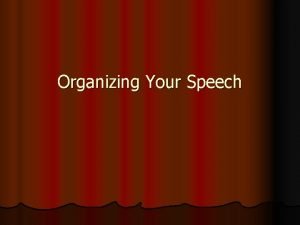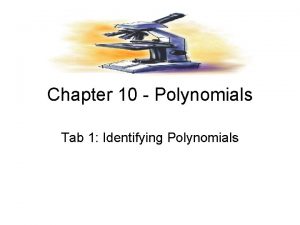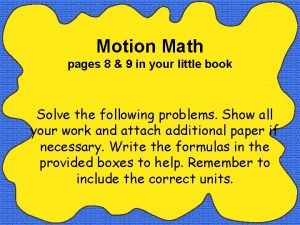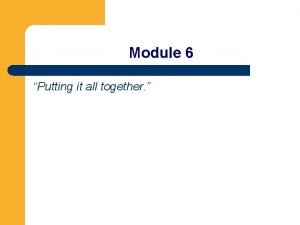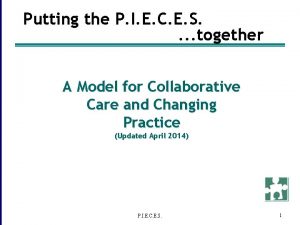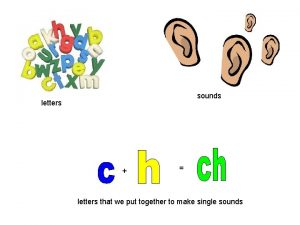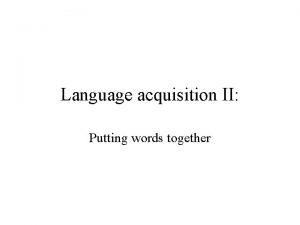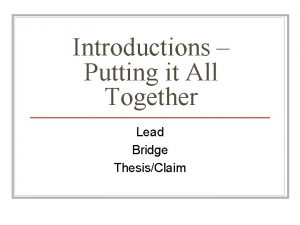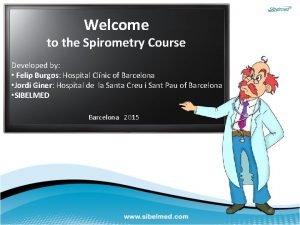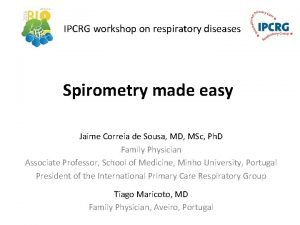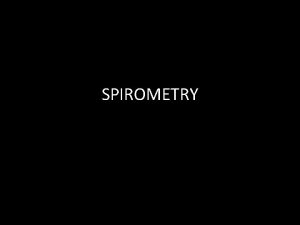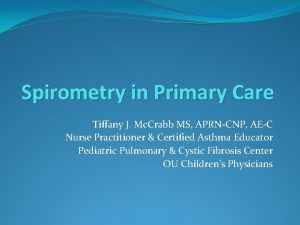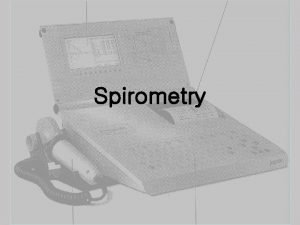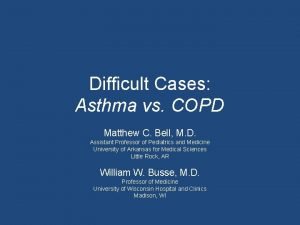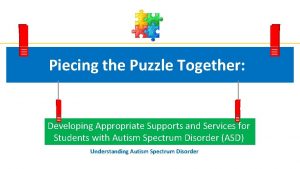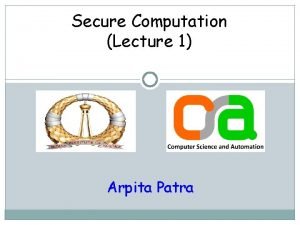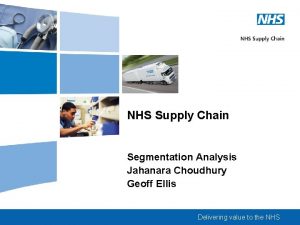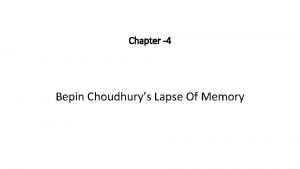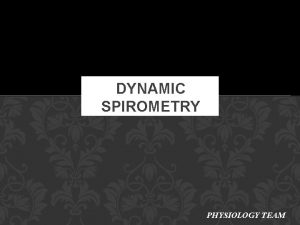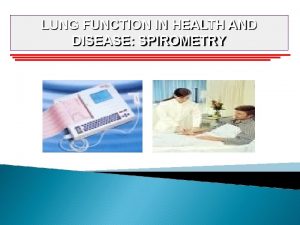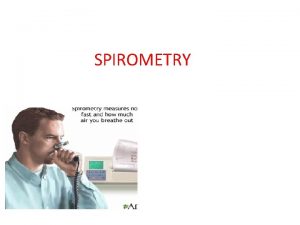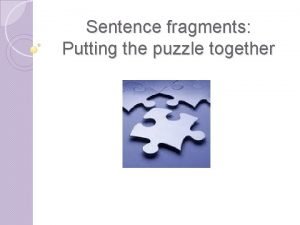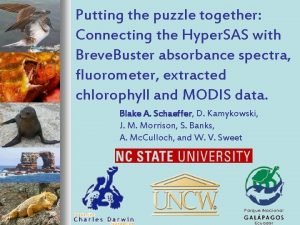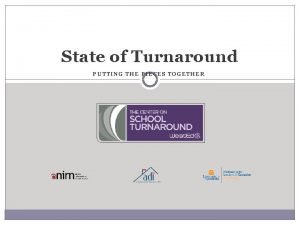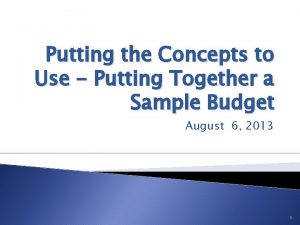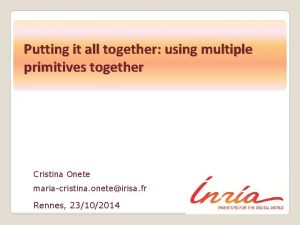Spirometry Putting the Puzzle Together Rasheda Choudhury Senior






























- Slides: 30

Spirometry: Putting the Puzzle Together Rasheda Choudhury Senior Respiratory Physiologist Adult Respiratory Care and Rehabilitation ARCa. Re


Anatomy and Physiology Trachea Bronchioles Narrowed Healthy Inflammation Airways are and constriction clear and - airways are open. swollen and No swelling muscles tighten and muscles around airways are relaxed Mucus blocks the airways

Objective of Spirometry • Spirometry is a diagnostic test performed to identify abnormalities in the airways and lung volume • It is the gold standard in the diagnosis and assessment of COPD • Performed in accordance to ARTP (Association of Respiratory and Technology Physiology) guidelines and standards

Performing Quality Assured Spirometry 1. Prepare the equipment: • Clean and safe to use • SABA Calibrated using 3 L syringe LABA before every session 4 HOURS 8 HOURS • Machine works! – Quality Control 2. Prepare the patient: • Gain consent. LAMA • Check for contraindications: 36 × Recent surgery Absolute if 4 -6 HOURS × Recent chest infection weeks × Chest pains

3. Record accurate height, weight, ethnic origin and age: - Asians: 10% lower vital capacity (VC) than Caucasians - Afro-Caribbean: 13% lower VC than Caucasians

25 Years Equations for predicted values are valid 55 Years between the ages 20 -60 years. Therefore, caution must 75 be. Years exercised in the interpretation of the spirometry results in the very young and very old. ` ↑ Age ↓ VC

4. Position: - Sitting comfortably (standing is not advised) - Back straight - Legs uncrossed

5 a. Slow Vital Capacity (SVC): • Patient takes big breath in • Blows out gently and steadily for as long as they can • At least 3 good blows (BTS/ARTP standard) b. Forced Vital Capacity (FVC): • Patient takes big breath in • Blows out fast and hard for as long as they can • At least 3 good blows (BTS/ARTP standard)

Normal Spirometry Volume (Litres) Time (seconds) Volume (Litres) A rapid start to a sharp peak with linear flow until FVC is reached (usually 4 -6 seconds)

Errors in Technique Extra Breath Sub-Maximal Effort Slow Start Coughing Early Termination

Measurements FEV 1: Forced Expiratory Volume in the 1 st Second The volume of air in litres that can be forcefully and maximally exhaled out in the 1 st second after a maximal FEV 1/FVC Ratio (%) inspiration. This ratio is used to determine normal, restrictive or FVC: Forced Vital Capacitylung disorders. obstructive The volume of air in litres that can be forcefully and maximally exhaled out after a maximal inspiration. Relaxed/Slow Vital Capacity (SVC) – similar to FVC, but slow maximal exhalation

Interpretation 3 Easy Steps: 1. Flow Volume Loop 2. FEV 1/FVC Ratio 3. FEV 1 % Predicted and FVC % Predicted

Flow Volume Loop: Normal Flow volume curve between peak and FVC is approximately a straight line due to relative uniform emptying of lungs. FVC

Normal

Flow Volume Loop: Restrictive Flow volume curve shows a similar shape to a normal curve but with a reduced FVC and/or FEV 1. Curve is squashed to the left indicating reduced lung volumes due to a drop in lung compliance (stiffening of the lungs, e. g. pulmonary fibrosis

Causes of Restriction - Obesity Pulmonary Fibrosis Sarcoidosis Scoliosis Pulmonary Oedema Muscle Weakness Previous Surgery, e. g. lobectomy or pneumonectomy

Restrictive

Flow Volume Loop: Obstructive Flow volume curve shows a smooth curvilinear drop in flow with respect to volume indicating flow limitation, e. g. asthma. Chronic – early collapse of large airways and sudden drop in flow, e. g. emphysema.

Causes of Obstruction - COPD Asthma Bronchiectasis Cystic Fibrosis (CF) Tumour in the airways Foreign body in the airways

Mild Obstruction

Moderate Obstruction

Mixed: Restrictive and Obstructive

Causes of Mixed/Combined Multiple Pathologies: - Kyphoscoliosis and COPD - Tumour and COPD

Bronchodilator Response Asthma or COPD? - Salbutamol: 100 mcg MDI x 4 puffs with spacer or 2. 5 mg nebules via nebuliser 15 minutes 3 Forced Vital Capacity manoeuvres BD Difference = (Post FEV 1 – Pre FEV 1) x 1000

Positive Reversibility: 430 ml increase in FEV 1

Interpretation Flow Chart

Spirometry Training • Performing spirometry with no training = poor standards • Machines not calibrated / cared for • Minimum standards of acceptance • Poor interpretation Incorrect diagnoses and treatment management

Quality of Diagnostic Spirometry • New ARTP Framework for certificate of competency • Improve the quality of spirometry by establishing a national register of certified healthcare professionals. • Full implementation by April 2021. • Re-certification every 3 years

Any Questions? Feedback / Contact: Rasheda. Choudhury@bartshealth. nhs. uk Rasheda. Choudhury@nhs. net @THspiro @NHSBarts. Health
 Together
Together Strategic organization helps speeches be more effective
Strategic organization helps speeches be more effective Putting it all together
Putting it all together Putting it all together motion answer key
Putting it all together motion answer key Practice: putting it all together
Practice: putting it all together Putting the pieces together case study answer key
Putting the pieces together case study answer key Putting letters together
Putting letters together Putting two words together
Putting two words together Putting things together is called
Putting things together is called Package mypackage class first class body
Package mypackage class first class body Example of bridge in introduction
Example of bridge in introduction Fleisch pneumotachometer
Fleisch pneumotachometer Irv
Irv Spirometry graphs
Spirometry graphs Olamizumab
Olamizumab Asthma vs copd spirometry
Asthma vs copd spirometry Asthma vs copd spirometry
Asthma vs copd spirometry Pft
Pft Examples of functional limitations
Examples of functional limitations Marco koper
Marco koper Arpita choudhury age
Arpita choudhury age Rbar
Rbar Romit roy choudhury
Romit roy choudhury Supply chain segmentation
Supply chain segmentation Fayezul choudhury
Fayezul choudhury Choudhury objective
Choudhury objective Bepin choudhury lapse of memory learning objectives
Bepin choudhury lapse of memory learning objectives Romit roy choudhury
Romit roy choudhury Putting the enterprise into the enterprise system
Putting the enterprise into the enterprise system Putting objects in perspective
Putting objects in perspective Putting the enterprise into the enterprise system
Putting the enterprise into the enterprise system

